DICK MORANT IS DEAD: THE AWAKENING
By Coral Hull
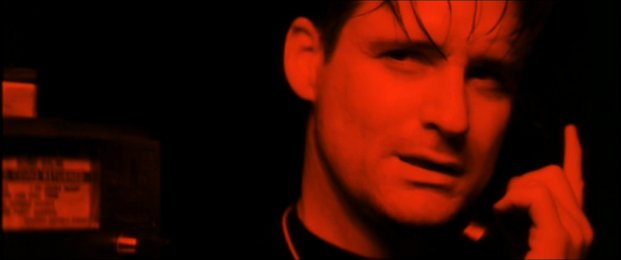
[Above] Fred Madison receives the message. (Lost Highway, 1996)
"Nothing has a fixed or essential nature that will not change as it comes into relationship with different ideas or experience. In this light, a true self is no self, for there is no fixed concept or structure of self that has a permanence and will not change. The idea of clinging to some "sense" of self, protecting it, fighting for it, is illusory. There is no "self" apart from that which it is in relation to." - Elaine Schwager
Part 1 - The Haunted House As Psychic Landscape
"Fred: And there you were lying in bed. It looked like you but it was not." Appearances are deceiving and the presence of a physical body does not necessarily mean that there is only one self. In the David Lynch film Lost Highway, we follow the central psyche of a man that is populated by three autonomous selves; a saxophone player, a mechanic and a psychic entity. The movie explores the parallel realities of different selves existing within the one physical body. The first indications of inner communication replacing an inner lack of awareness are when the protagonist Fred Madison receives the message through the intercom: "Dick Morant is dead".
The story of Lost Highway begins with the saxophone player Fred Madison, who is living with his enigmatic partner Renee Madison. The couple seem to share a dream like-relationship, intense, mute and remote which would suggest an immediate lostness or isolation from other aspects of the psyche for the main character, Fred. They soon become aware that someome is videotaping their premises, not only from the outside but from the inside. This would suggest that 'someone', is not only outside the house, but inside the house with them. Or in the case of the unaware and disordered multiple Fred Madison, inside the central psyche with him.
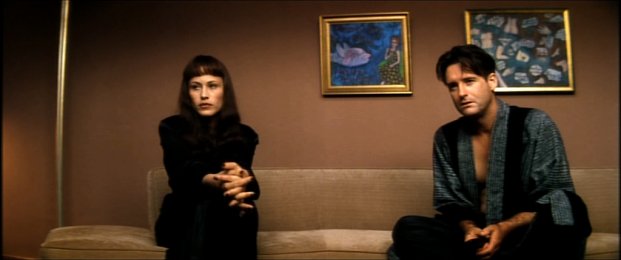
[Above] Fred and Renee Madison at home. (Lost Highway, 1996)
The house itself seems to represent the unexplored aspects of the human psyche. We follow the protagonists Fred and Renee Madison, into dark unknowable unseeable patches, of the kind of impenetrable ignorance, where fears and irrationality are born. Like them, we fear what we do not know. In this case, the dreamlike external environment that Lynch sets up is representative of the internal psychic environment of the main protagonist Fred Madison. It reminded me a little bit of The Shining in the Overlook Hotel, where the more lost the psyche of the main character became, the more found and alive the haunted motel rooms appeared to become, until both haunted hotel and haunted psyche were engaged in a battle for conscious control. In such a haunted environment, it often appears as if one state of being could clearly be exchanged for another.
The psychic backdrop of the Madison residence includes: telephones ringing in each room - never answered, disembodied voices through the intercom, strange unaddressed parcels arriving on the doorstep, a mysterious woman and a police investigation, whereby the unknown must be made into the known. The echoey quality and deep muffled voices are a reflection of the psyche that creates distance and dissociation within relationships, both within the physical landscape and the internal psychic landscape of the main character Fred Madison.
Reality is fragmented and unknown and selves separated and closed off from each other. The characters take turns at walking into the darkness of the building (or the psyche) and disappearing, or sitting beside portraits of shattered human parts or strange beings approaching, suggesting both fragmentation, disorientation and potential danger. Fred Madison first gains awareness that his own central psychic space may be inhabited by others, when he projects this onto his external environment saying: "I thought someone was inside the home."
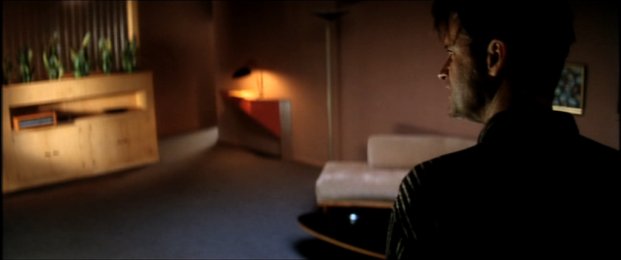
[Above] Fred Madison thought someone was inside the home. (Lost Highway, 1996)
The mind (as represented by the home) is no longer safe. The inner dialoging within Madison's disordered multiple psyche begins and when (he channels) or listens in, the intercom says, "Dick Morant is dead". That self that he has dissociated from (mechanic Pete Dayton), as it turns out, has murdered Dick Morant. It's not acute schizophrenia, as has been suggested, but a lack of awareness regarding a multidimensional consciousness. Madison looks in the mirror at himself - representing a search for self or identity. He is lost and we see at this moment a shadow (his shadow self) moving across the loungeroom wall - representing the unknown psyche.
Madison then apparently keeps receiving these videos on the front step, showing more and more of his house (his psyche) as awareness looms. First there is a video taken of outside the house and next from inside the house, until this video finally shows that he has murdered his partner Renee. There are early indications that Fred somehow knows about these videos straight away, or indeed that he may have experienced another life.

|
At first we think it is someone else, outside his body, until the police suspect that Fred may be involved and begin to question him. There is a good chance that Fred Madison is actually making the videos within his own house and posting them back to himself without awareness, since the psyche is so split. This is later implied when he makes a telephone call to himself. He calls from a bar and he also picks up the call from the other end inside his own house. It is as if the entire external landscape may also be a psychic backdrop in order to explore a very disordered form of multiplicity, otherwise known as MPD (Multiple Personality Disorder). |
[Above] Mysterious unmarked envelopes appear on the Madison's doorstep. (Lost Highway, 1996)
The central psyche of the protagonist Fred Madison/Pete Dayton is being explored on two levels. Firstly, through his actual physical presence and the contents of a video. On this video he eventually sees himself and that he has murdered the woman that he is living with. How does this occur? Well, he may have set the video on in the room to film the murder or alternatively the video is representative of his awareness of the situation. Once the murderer is taped, the murder has occurred, because then we cut to a scene with the authorities (inner conscience) where Fred is smacked in the face by a detective who is accusing him of killing Renee.
This video taping may suggest a dissociation from the victim or the situation, that is, that Madison can only access that part of his mind by watching videos that someone else sends him or viewing his life from an outside perspective. Or alternatively, that he is multiple with a disordered operating system of selves, so that while his body may have committed the murder while one self was conscious and in control, the other self that existed or lay dormant, or who was unconscious, or preconscious within the central psyche, did not commit the murder.
When Lynch shows the switch in consciousness from Madison to Dayton, he doesn't just show change in voice or facial expression, they switch physical bodies as well! Not suprisingly, each of the main characters - Fred Madison the saxophone player and Pete Dayton the mechanic - experience 'lost time' as well as 'lost memory', where they are each unable to remember what the other one did, since there is no awareness of what kind of life the other one has been leading. Lynch also surmises that this may be a choice within the central psyche itself, when Madison says: "I like to remember things in my own way." When the police officer asks, "What do you mean by that?" Fred Madison answers, "How I remember them. Not necessarily the way they happened."
This may be the closest the protagonist comes to the truth, or at least an awarenes of his disordered internal psychic landscape, where the outer detectives on the trail of solving the murder mystery of the external physical landscape, also represent the inner detectives, or the emerging awareness within the central multidimensional psyche of the Fred Madison/Pete Dayton protagonist. The detectives represent the conscience of humanity.
Only in the very last moments of Lost Highway, do the detectives (again) catch up with the self of Madison, as he switches places with the self of Dayton in order to assume control. Simultaneous awareness of the situation occurs for the police, as well as Madison, as his own inner awareness comes rushing to the surface, in what appears to be an explosion or collision of electrical brain discharges or psychic energy, where his face shakes and all realities between the selves are blurred into a state of intense confusion, or a crisis of consciousness.
In the meantime, the murder of Renee Madison has taken place and Fred Madison is found at the scene of the crime and arrested by the police. He is placed in prison and, no sooner is he incarcerated, than a psychic disruption begins to occur as is represented through the lights above his gaol cell. Then, alone in his cell, after being taken in for the murder of Renee Madison, it seems that Fred Madison (who will soon switch conscious positions with Pete Dayton the mechanic) will not understand what has happened, but both will have flashbacks.
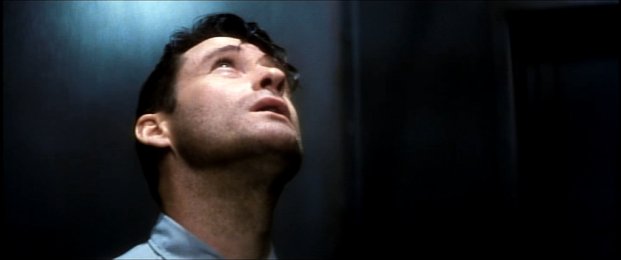
[Above] Fred Madison in gaol for the murder of Renee Madison. (Lost Highway, 1996)
The electrical discharges that occur throughout the film are representative of the electrical brain storms within the central psyche of the disordered multiple protangonist. Light switches, phonelines and intercoms become the means of communication into the mind itself. We are lost within this surreal landscape, as much as the protangonist is lost within his own psychic landscape. Perhaps the prison guards also become part of his own mind and may now also be representive of other selves existing within the central psyche. The "authorities" are the first to become aware that they may be dealing with two entirely separate people within the one body. However in this case, Lynch pushes the metaphor and, as the switch of consciousness occurs within the multiple central psyche of Madison/Dayton, so too, does the physical body change in order to accommodate the switch.
Bewildered by the physical transformation that accompanies the psychic transformation of Fred Madison into Pete Dayton, the authorities approach the cell (with the flickering lights suggestive of continuing psychokinetic activity) together, only to find that this prison cell is now seemingly occupied by a different man from Madison.

[Above] The Authorities of Conscience confront 'some spooky shit'. (Lost Highway, 1996)
"That's not Fred Madison.
No, it's not.
Well who is it?
See for yourself
That's not Fred Madison
No Sir. It's not.
Who is it?
I couldn't say sir.
Captain Lenů..
Yeah Mack
Captain. This is some spooky shit we got here."
After checking their records the police reach an uneasy conclusion regarding the situation.
"Well gentlemen, we know who the stranger is."
Part 2 - Pete Dayton The Young Mechanic and Alice Wakefield
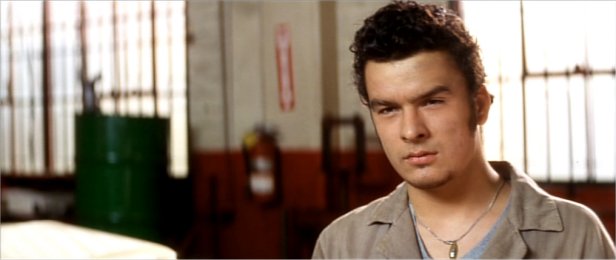
[Above] Pete Dayton the mechanic. (Lost Highway, 1996)
Once the switch has taken place from Fred to Pete, we then follow the life of the 24 year old man back home, after the police have released him from gaol. This young man is Pete Dayton. At first Pete seems slightly disorientated, as if he has no memory, or is at the very least estranged from what appears to be his old familiar environment. We find out through other people that Pete works at an auto garage - and that he's back. There is the suggestion is that he hasn't been around for a while. This is indicated by people's greetings. The reason he has not been back for a while, is because he has been preconscious (or unconscious) while another self has had physical control over the body. In less inaccurate terms one might say that Pete has been living as someone else. But in this case the body has been controlled and utilised by a saxophone player, Fred Madison.
In this instance lost time is experienced because Pete doesn't really know where he has been. This type of psychic amnesia is experienced by some multiples who are unaware of the existences of the other selves, or, who for reasons only known to them, are not as yet working together as a co-conscious system within the one psychic space. Pete starts to become aware of having memories of having lived another life. He begins to have flashbacks. Someone in his own psychic space, who was unknown to him and therefore out of his control, has been in control of the physical body. As the story progresses, we then find out that the three selves who exist in parallel physical realities, or alongside each other within the one central psyche, are all guilty of murder.
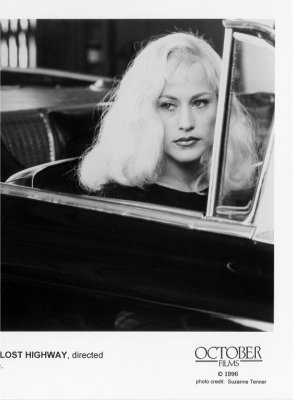
|
Pete Dayton becomes attracted to and proceeds to get 'mixed up' with Alice Wakefield - another Lynchian femme fatale. The women in this Lynch film are much the same as the women in all Lynch films. They are hardly substantiated aside from being cool objects of erotic remoteness. They are often helpless and in distress, thereby rendering them more sexually appealing. They are used by Lynch primarily as sexual lures and murder bait, little girls dressed up as 'whores' flashing a bit of tit. Lynch's main concern with women appears to be as auto-erotic masterbatory fantasies.
During their risky sexual liasions Pete and Alice are followed by yet another unmarked car. The cars and roads seem to represent the separate streams of consciousness operating within the one psyche. They are meeting places and vehicles of communication, taking the selves on small journeys along the lost highways. The powerlines and phonelines are the moving streams of conscious interaction, through what would otherwise be a very still and haunted landscape permiated by silences and selves moving in and out of shadows and light, minimalistic and empty. |
[Above] Alice Walker. (Lost Highway, 1996)
The scene where the thugs from one of these 'communicators' (unmarked vehicles) senselessly bash an innocent driver is suggestive of inner as well as outer psychic disharmony and predation, whereby one self runs the other self off the road within a shared physical and psychic landscape. The psychopathic gangsters bash a driver unconscious and leave him injured and bleeding on the side of the road. This scene is in direct correlation to the psychopathic self (The Mystery Man), who takes over the mind of the protagonist Fred Madison/Pete Dayton, leaving all sides injured, afraid or bewildered. There is a struggle for control or domination, both within the external and internal worlds. One cannot exist without affecting the other. Both landscapes are interrelated.
Meanwhile, the young mechanic Pete Dayton starts to hear the saxophone played by Fred Madison, with whom he shares the central psyche and physical body, on the radio. The invisible amnesiac walls between the two selves began to blur, but, unable to resolve this oncoming awareness within 'himself', the young Dayton switches off the radio. Lynch employs the 'physical switching' to confuse our perception of what is real and what is not, or who is real and who is not. This serves the purpose of shaking our sense of reality or our ideas of selfhood and attempts to show the confusion that can occur when selves within the same psyche are unaware of each other.
The young mechanic Pete Dayton begins to complain of the same headaches that have plagued the saxophone player Fred Madison, again indicating intense psychic pressure within a shared physical body.
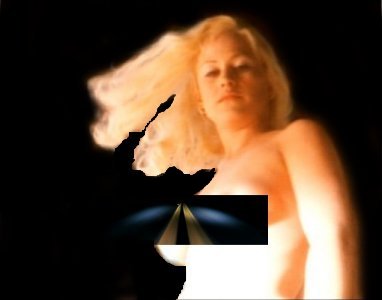
|
Pete Dayton then proceeds to project his fears (of a past existence) onto Alice Walker, mistaking her for Renee Madison.
"Is that you?
Are both of them you?
Where the fuck are you going Alice?
Where the fuck are we going?
We have to go to the desert, baby."
Everything occurs simultaneously which seems to imply a sense of precognition, inescapable fate or fatal circumstances. Soon Pete Dayton switches with Fred, as Fred Madison again takes over the central psyche, now influenced by a third psychopathic self - The Mystery Man.
"What the fuck is your name?" |
[Above] Alice Walker leads Pete Dayton into the desert. (Lost Highway, 1996)
Identities are interchangeable both in the pornography industry and in the case of multiplicity. We can be more than one person at the same time, as well as sharing the physical body and central psyche with more than one person. The idea of consciousness and/or selfhood is not fixed and neither is the time or space of the external environment. The woman Pete Dayton dances with (Alice Walker) has the same nail polish as the woman that Fred Madison lived with (Renee Madison), indicating that positions (both physical/psychic) are interchangeable.
The reason the Madison/Dayton system first see "her" or "them" as a brunette and then a blonde, is that the different selves within his one central psyche see her as different women. The photo then only had one woman. In other words, these two different selves may have been viewing the photo simultaneously and seeing two different women. Selves can exist within a multiple psyche, simultaneously switching from one perceptual mindstate to another, but Lynch pushes this idea, where the a number of autonomous selves also exist within parallel and interlocking physical realities, that are doomed to replay themselves into a loop - the mobius strip.
The characters along the Lost Highway are genuinely frightened and cannot figure it out. After the murder of a gangster thug (Dick Morant) takes place at the hands of Pete Dayton, or more accurately while Pete is conscious, Fred Madison then goes back to the same house where Fred and Renee Madison "once" lived (or will live again) and says, "Dick Morant is dead". Unless Madison was told of this murder before it occurred, thereby becoming precognitive, this intentional duplication and employment of the mobius strip of interlocking eternally bound parallel realities, brings the plot full circle, until there is no further sense of past or future. In this context linear time as we know it ceases to be and all events may be happening at all times, simultaneously.
All can and now will exist in the present moment. This only heightens or intensifies the oncoming crisis of awareness between the selves of Fred Madison and Pete Dayton, that threatens to blow the cover of two separate perceptual realities, lived within the one physical body and central psychic space. Inner awareness is inevitable, as both Madison's and Dayton's glimpses of recognition of each other pursues them, as do the police (the authorities of conscience), since Madison and Dayton are now both murderers in the external world.
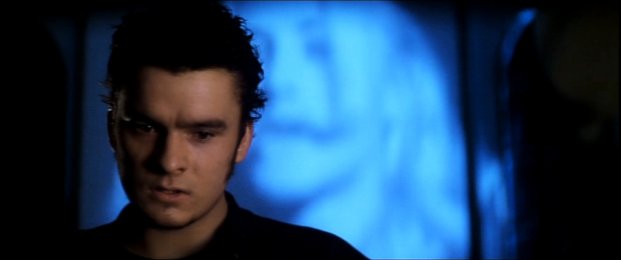
[Above] Pete Dayton suffers from inexplicable flashbacks and disorientation. (Lost Highway, 1996)
The circular narrative suggests that the experiences may occur simultaneously, or in the case of multiplcity there may be simultaneous perceptions of the same event from within the one central psyche. Not only does Lynch show the multiple as changing physical appearance in accord with the dominant personality, but as the events come full circle, there is now an actual separate physical self whispering the message about the murder through to another self down a phoneline. If this actual physical landscape is representative of an internalised psychic landscape or a vast and complex inner world, then it makes perfect sense to promote the existence of separate physical selves. It is simply as if this haunted unaware psyche is whispering messages back to itself.
Part 3 - The Mystery Man and The Return of Fred Madison
The psychopathic self or invading psychic entity (The Mystery Man), whispers into the multiple protagnist's ear, suggesting that an inner dialogue is taking place, but with a third party now involved. While The Mystery Man can enter and thereby influence the central psyche that is occupied by the selves of Madison and Dayton, he does not appear to be another self, since he exists outside the physical body of the Madison/Dayton system.
Aside from the physical switch between Madison and Dayton, the parallel realities (or shared consciousness) that exists between all 3 characters remains blurry. The amnesiac walls of MPD (Multiple Personality Disorder) are in place throughout the movie and the mystery to be solved will actually occur upon the collapse of these walls between the selves and the recognition that they all, in fact, share the one central psychic space. Therefore Lost Highway would appear to be about a 'crisis of awareness' between selves within the one physical body. This would suggest that, while we live in three dimensions, the nature of human consciousness is multi-dimensional, hence the resulting and ongoing conflict between alternating dimensions and realities.
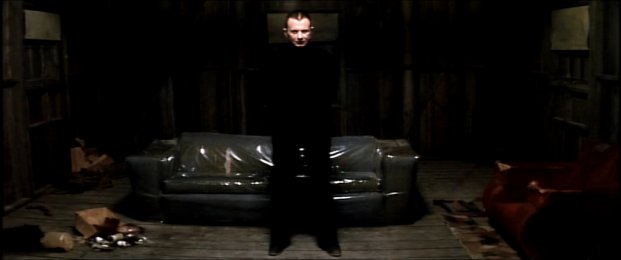
[Above] The Mystery Man. (Lost Highway, 1996)
When the Madison/ Dayton system is confronted by a third psychopathtic self (refered to as "The Mystery Man"), it is a communication that appears to be based in a physical reality, however, that closely represents inner dialoging between the selves, within the one central psychic space. The Mystery Man appears to connect them both via the murders that have taken place or that will take place again and again and again and again. Without self awareness the selves are destined to repeat the same mistakes over and over again.

|
Jung said: "That which we do not bring to consciousness appears in our lives as fate". Therefore awareness is freedom.
Or as Lynch himself puts it; "There is no such thing as a bad coincidence."
"We've met before haven't we?
I don't think so.
At your house, don't you remember.
(In your mind, right now.)
How'd you get inside my house?
You invited me. It's not my custom to go where I am not wanted.
Who are you?" |
[Above] The Mystery Man's face. (Lost Highway, 1996)
The external situation proves to be a multidimensional mobius strip, where physical reality becomes as layered and complex as the central psychic space of a multiple system, with each situation (or self) dependant on and affecting the other at all times. So that when the inner detectives as well as the outer detectives can't solve the mystery, those involved risk becoming lost from themselves or the outside selves (outsiders) within their external physical environment, as well as within the unknown and haunted landscape(s) of the central psyche.
Towards the end of the movie, we are left with an image of Fred Madison, obviously lost on a dark highway, as representative of the continuing lack of awareness and co-consciousness between the selves. While Madison drives, he is apparently physically alone, but far from psychically alone, since he appears to undergo some kind of dramatic internal transformation, as if someone else is attempting the break through the skin of his face!
The ongoing inner fight for conscious control of the central psyche and the physical body takes place between two separate centres of awareness (or selves), in this case the selves of Fred Madison and Pete Dayton. The Mystery Man (as external psychic entity) obviously has influence over the central psyche of the Madison/Dayton system, but he appears to also be separate and apart from it. This would suggest that The Mystery Man may be some form of disembodied consciousness existing within the universal ether, who is able to enter and possess the unstable psyche of the disordered multiple personality protagonist. This is a common thread to be found and discussed in a variety of texts on both multiplicity, multiple personality disorder and spiritual mediumship.
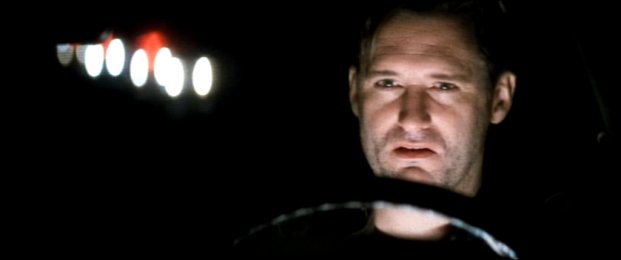
[Above] Fred Madison drives along The Lost Highway. (Lost Highway, 1996)
Conclusion
The self of Pete Dayton may not be aware of the actions of Fred Madison and visa versa. Only towards the end of the movie do we see that Fred Madison was actually giving himself the message. For the selves within a multiple central psyche, it can often seem as if they exist in two parallel realities, or in two places at the one time, as they have their own perceptions and experiences and yet also have vague memories regarding the conscious lives of the other selves. This is what I believe David Lynch is portraying in this instance. The messages come from the other selves via shadows, holograms, trance states, phonelines, intercoms, corridors and empty rooms of unknowable and suggestive darkness and accompanied by the psychokinetic or, electric-kinetic phenomena representative of brain activity and the merging of physicality and consciousness.
Lynch explores the disordered version of multiplicity. The central psyche is a scary place, inhabited by ghosts or the ghost of unawareness. In the external world, we gravitate towards those who represent unresolved issues within our own psyches. Until awareness and co-consciousness between the selves is achieved, there can be no real relationship based on mutual nurturing, awareness and understanding of the others and of the situation that each finds themselves in. So will we all be cast in the roles of non-empathetic two dimensional characters living in barren cardboard cutout environments. It's already happening. Lynch merely combines all the elements, so that it appears as a exaggeration. In fact, the portrayal of the world as the central psyche slowly being overtaken by a combination of dread, continuing uncertainty, non-awareness and the two dimensional world of psychopathy is entirely accurate. Lynch doesn't push reality too far, he simply expands upon an existing reality.
In Lost Highway we are given a brief glimpse through a window in time without historical context or geographic location. Situations appear to happen either in a circular fashion or simultaneously. Lynch also actualises the body. He gives each self a psychological identity and a physical presence to match. However the characters and selves in Lynch's universe tend to move from darkness to darkness while stuck on a carousel. Their world is one from which they cannot escape, no matter how many highways they drive down. They are trapped and lost within the unawareness of their own situations. Sooner or later they will be overtaken by this awareness.
There is a struggle to remain conscious amidst the blinding headaches and headspins. I suspect that the dominant self is the young mechanic Pete Dayton, since there were family relations and work aquaintances observing his disappearances when he was knocked out of consciousness by another self, Fred Madison. This is the fate of a disordered multiple system, where each self within the haunted house of the central psyche can only guess at what may have been occuring during these lapses, where for that time, they did not exist.
Lynch explores a basic form of disordered multiplicity that can occur within the central psyche where the selves are lost from each other. Lost Highway appears as a physical landscape when it is actually a psychological one. The humming, buzzing flickering lights and intermittent electrical charges and discharges correlate closely to the main characters mental trauma, which would suggest the existence of RSPK (Recurrent Spontaneous Psychokinesis) alongside multiplicity. The electricals represent brain activity and while the characters' also appear to take on the associated phenomenon of precognition. Predictions have to do with other selves and situations which have already occurred, or are occurring simultaneously, since linear time has been collapsed.
Sadly, there appears to be no guiding force of a benevolent universal consciousness present, except for a moment of intimacy in the desert, in front of the car, where the headlights turn out to be more enduring than the love between the two protagonists. Love is as unformed as the psyches of many of the main characters. While Madison drives his car down the highway, we float about in a kind of psychological limbo. When we enter the world of multiplicity, MPD and RSPK, we are entering unknown territory where physical and psychic boundaries collapse into each other. Whether we realise it or not, the entire notion of existance and consciousness remains largely unknown, whereby along the way, human beings are more often than not overcome by fear. As a result, they destroy their own lives and the lives of others. By doing so, they drive their consciousness down that dark and lonely road to inner and universal awareness, along Lynch's Lost Highway.
About the Writer Coral Hull

|
Coral is the author of over 50 books of poetry, prose poetry, fiction, artwork and digital photography. Born with Autism in 1965, she was raised under disadvantaged circumstances in the working class suburb of Liverpool in Sydney's outer west. Coral became concerned with issues of social justice and spirituality from an early age. Coral became an ethical vegan and an animal rights advocate who has since spent much of her life working voluntarily on behalf of animals and the environment, both as an individual and for various non-profit organisations. She is also the Executive Editor and Publisher of Thylazine: an electronic journal featuring articles, interviews and reviews of the recent work of Australian writers and artists. Coral Hull's complete works are now available from Artesian Productions (Darwin, Australia). Coral holds a Doctor of Creative Arts Degree (Creative Writing Major) from the University of Wollongong. An extensive biography, list of publications, festivals, interviews, articles and reviews are online. Coral is The Director of The Thylazine Foundation: Arts, Ethics and Literature. Coral Hull's work is in the public domain for non-commercial use under the Creative Commons License. |
[Above] Coral Hull, Elliot Hotel, Elliot, Northern Territory, Australia. (Photo by Coral Hull, 2001)
I Next I
Back I
Exit I
Thylazine No.11 (June, 2006) |



